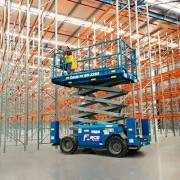Access Equipment Jobs: Warehousing
If you’re a young person looking for a career with a lot of growth, you might want to explore a job in warehousing.
Growing industry
According to the Department of Employment, about a half-million Australians work in warehousing and logistics, and that number is set to grow another 7% by 2017. The news gets better. The Department of Employment also says this industry category, compared to all industry categories, has the lowest proportion of workers between 18 and 24, and the highest proportion of workers over the age of 45. That means even more jobs will be opening up as the current workforce starts to retire. Climbing the ladder to management is a very good possibility.
Part of this impressive growth in the warehousing job market is due to the recent increase in on-line shopping and the associated demand for warehousing and shipping services.
Good news for EWP operators
For people interested in a career using elevated work platforms, the news is even better. Warehouse workers are generally better paid than general labourers in factories, and lift operators are near the high end of the pay scale in warehouses. There are qualifications required for lift operators, but there’s more to warehousing than just that, and nationally recognised courses are available to expand your skills. Courses include driving operations, warehousing operations and logistics. The Australian Warehousing Association, a relatively new group, already offers a range of training (some of it online) and is expanding its course selection all the time.
Be prepared for a variety of working conditions
Since just about anything you can imagine is warehoused at some point, and working conditions vary wildly. You could be warehousing books or dangerous chemicals, and the safety precautions required are obviously very different. In some cases, you may require a high risk work license.
One special environment is cold storage. While the body can usually cope with heat, it is reluctant to adapt to cold conditions. People with circulatory problems are particularly at risk of cold stress, which can cause a loss of mental alertness—a very bad thing for a lift operator.
In order to work in a warehouse, you should be fit and be prepared to be active. There is a lot more moving around than there is for most jobs on a factory floor.
All kinds of access equipment are used in warehouses. The most common machine is a forklift, but material lifts that are pushed by hand are also common. For jobs requiring great height, scissor lifts are very useful. The stability of the platform on a scissor lift also makes it ideal for things like taking inventory. For high up and hard to reach areas, you may need to know how to operate electric boom lifts, electric knuckle booms and telehandlers.
Warehousing is a growing industry, so if you’re physically fit and looking for a good opportunity, it is worth exploring.



